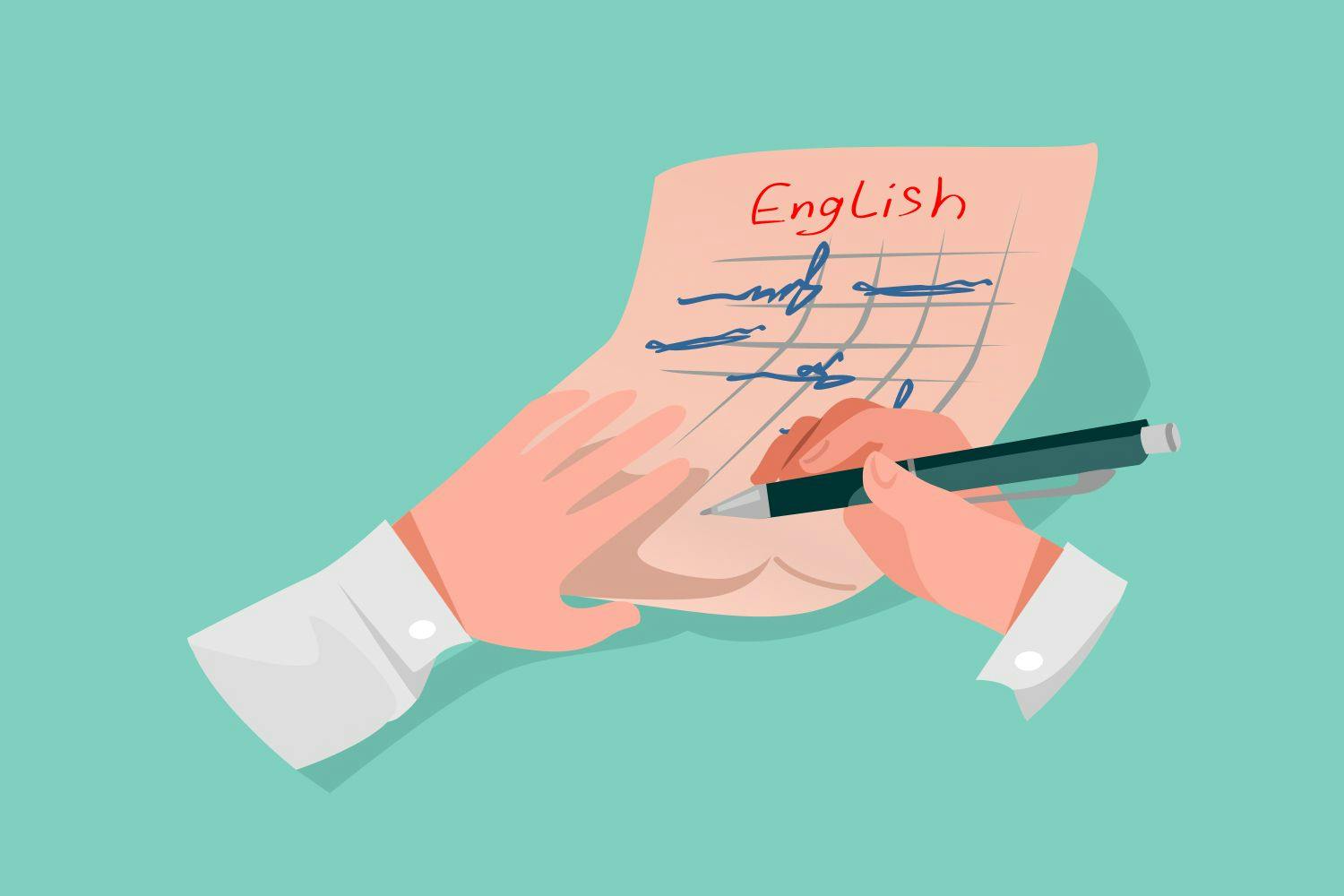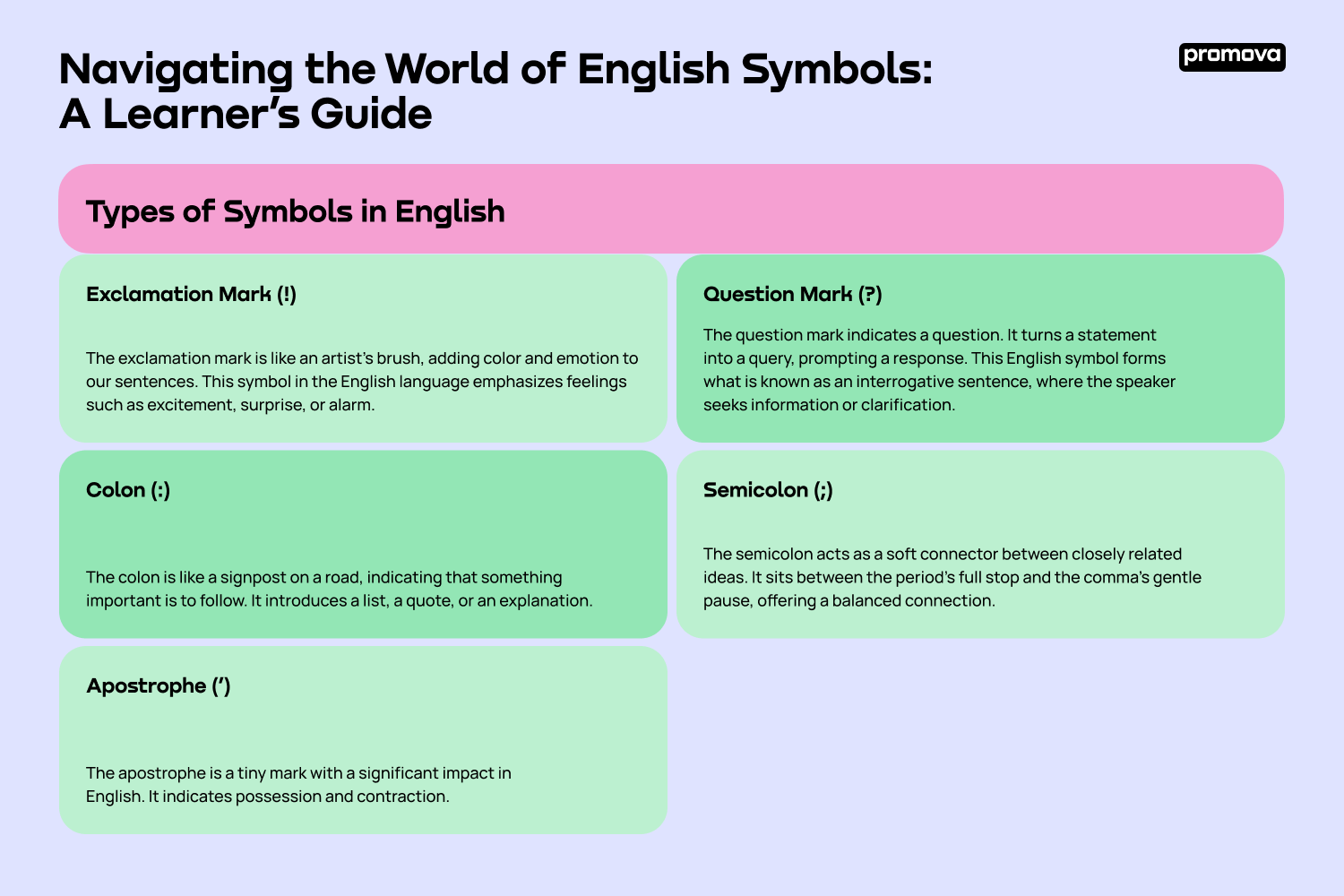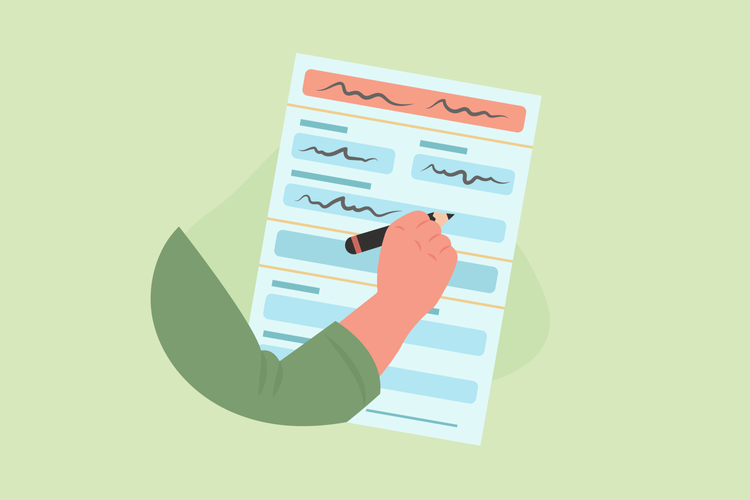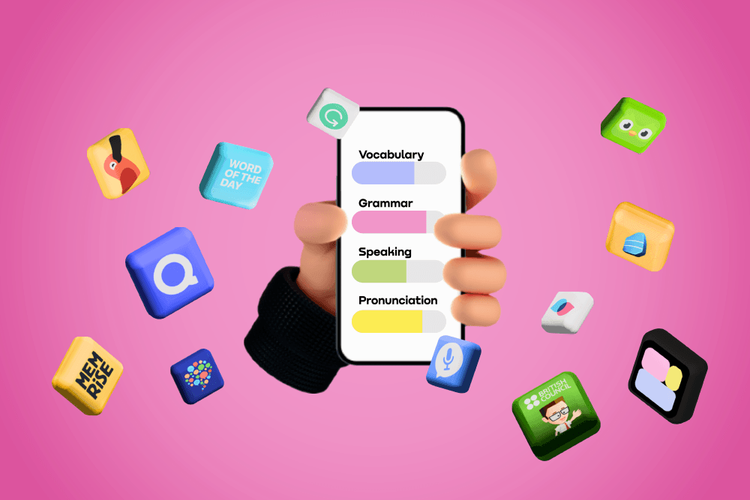Navigating the World of English Symbols: A Learner’s Guide


You will get a promo code with a discount for our app courses after reading this article.
Contents
Imagine navigating a city with no signs. Well, that’s exactly how language would be without symbols. English symbols serve as essential tools, directing the flow of ideas and adding nuances to communication. They are the powerful, silent operators that structure our thoughts and give wings to our expressions. This guide will walk you through the world of symbols, revealing their unique roles, meanings, and applications.
Types of Symbols in English
The English language abounds with symbols, each serving a distinct purpose to add structure, clarity, and variety to our communications. Let’s explore these elements in detail, understanding their roles and uses in different contexts.
Period (.)
Commonly known as the full stop, the period is arguably the most fundamental symbol in English. Its primary role is to signify the end of a sentence, thus providing a clear demarcation between different thoughts or ideas.
For instance, in the sentence “She finished her work.”, the period signals that the statement is complete. Additionally, periods are used in abbreviations, such as “Dr.” for Doctor and “U.S.” for the United States.
Comma (,)
The comma serves many functions in English. It separates elements within a sentence, creating a pause that enhances readability and comprehension. Commas are used in several contexts:
- In lists: “I bought apples, oranges, and bananas.”
- To separate independent clauses: “I finished my homework, and then I went to the park.”
- To offset nonessential information: “My brother, who is a doctor, lives in New York.”
- As part of dates, addresses, and numbers: “Today is April 15, 2022.”, “I live at 123 Main St., New York, NY.”
A comma is an essential tool for any English language learner to master, as it can significantly impact the meaning and clarity of a sentence. It can distinguish between a well-crafted sentence and one that is confusing or difficult to understand.
Exclamation Mark (!)
The exclamation mark is like an artist’s brush, adding color and emotion to our sentences. This symbol in the English language emphasizes feelings such as excitement, surprise, or alarm. Its uses are diverse, adding a strong emotional tone where needed:
- Expressing joy: “Hurray! We won the match.”
- Denoting surprise: “What a beautiful view!”
- Issuing a command: “Stop! Don’t cross the road.”
Following these examples, it’s clear that the exclamation mark is more than a mere symbol; it’s a dynamic tool that can transform a simple sentence into an emotionally charged statement.
Question Mark (?)
The question mark indicates a question. It turns a statement into a query, prompting a response. This English symbol forms what is known as an interrogative sentence, where the speaker seeks information or clarification. It also can express confusion or doubt.
- Direct questions: “What time is it?”
- Confusion: “Why did you say that? I don’t understand.”
Placing a question mark at the end of a sentence invites engagement, discussion, or thought, making it an essential tool for interactive communication. To use it properly, learners must understand the tone and context of a sentence to distinguish between different types of questions.
Colon (:)
The colon is like a signpost on a road, indicating that something important is to follow. It introduces a list, a quote, or an explanation. Here are some ways it can be used:
- Before a list: “The recipe requires the following ingredients: eggs, milk, and flour.”
- Before a quote: “She remembered her mother’s words: ‘Always be kind to others.’”
- Before an explanation: “He received what he deserved: a promotion.”
By separating yet connecting related thoughts, the colon brings clarity and structure to our sentences. As such, it is an important symbol to utilize effectively when writing in English.
Semicolon (;)
The semicolon acts as a soft connector between closely related ideas. It sits between the period’s full stop and the comma’s gentle pause, offering a balanced connection. Consider these uses:
- Between two related independent clauses: “She loves the sun; he prefers the rain.”
- In complex lists: “We have branches in Paris, France; Rome, Italy; and Madrid, Spain.”
As these examples demonstrate, the semicolon is a subtle yet powerful symbol for English, linking thoughts and ideas with nuance. With its diverse applications, it adds variety and depth to writing while maintaining coherence.
Apostrophe (’)
The apostrophe is a tiny mark with a significant impact in English. It indicates possession and contraction. Here are the different ways it’s used:
- Possession: “John’s book is on the table.”
- Contractions: “Don’t touch the stove.”
The apostrophe is integral to English writing, whether it’s demonstrating ownership or making our language more conversational through contractions. Mastering English grammar is essential to using the apostrophe correctly.
Quotation Marks (“”)
Quotation marks serve as the frame for words spoken or written by others. They encapsulate exact words, distinguishing them from the author’s voice:
- Direct speech: “She said, ‘I’ll be there in 10 minutes.’”
- Titles: “Have you read ‘To Kill a Mockingbird’?”
Through quotation marks, we acknowledge the originality of others’ words, offering credit where it’s due. The use of this symbol contributes to clarity and precision in English language communication.
Hyphen (-) and Dash (–)
Although the hyphen and dash may look similar, they fulfill different roles. The hyphen links words or parts of words, whereas the dash creates strong interruptions or denotes a range:
- Hyphen: “She has a three-year-old son.”
- Dash: “You are the one – the only one – I’ve ever loved.”
The dash emphasizes a sentence, accentuating the range or change in thought. On the other hand, the hyphen acts as a glue, joining words to ensure clarity and proper meaning. Understanding these subtle differences is critical in mastering the art of English punctuation.

English Language Symbols in the Digital Era
As we navigate through the digital era, symbols in English have adopted a more expansive role than ever before. The boom of digital communication channels, including social media, emails, text messages, and the like, has propelled symbols to the forefront, providing a new dimension to language expression.
In the digital age, English symbols and meanings have moved beyond their traditional roles, taking on enhanced significance and expanded use. They are now used to communicate tone, convey emotions, and even replace words. Emoticons and emojis are perfect examples. A simple smiley face symbol :) or a thumbs-up emoji convey messages that surpass language barriers, expressing emotions universally.
Hashtags (#) and at symbols (@) have evolved into powerful tools on social media platforms. Hashtags allow posts to be grouped under a specific theme or content, enhancing the visibility of a message. For example, #LearnEnglish might be used by English learners worldwide to share resources and exchange experiences. The at symbol is used to mention or reply to specific users, fostering direct interaction.
Also noteworthy are ellipses (...) and asterisks (*). In the digital realm, ellipses often indicate a pause or suspense, especially in informal contexts. For example, “See you soon…” might suggest a sense of mystery or anticipation. Asterisks are frequently used to denote action or correction in text-based communication. For instance, “sighs” or “I meant to type *are, not our.”
The rise of the digital era has certainly stretched the boundaries of symbol usage in English, incorporating them into everyday communication in new and creative ways. The continued evolution of digital communication will undoubtedly foster further transformations, reflecting the dynamic nature of language in response to societal changes.
13
Formal and Informal Usage of English Signs and Symbols
Every language constantly dances between formality and informality; English is no exception. This dance becomes even more intricate when we focus on symbols, those seemingly simple elements that significantly alter meaning and tone.
Formal English tends to adhere to traditional grammar and punctuation rules and is often characterized by longer sentences and more complex vocabulary. The use of symbols here follows a strict and standardized pattern. Consider the semicolon (;). In formal writing, this symbol represents a pause longer than a comma but shorter than a period, often linking closely related ideas. It’s a powerful indicator of complex thought and sophisticated writing style.
On the other hand, informal English, prevalent in everyday conversations, text messages, or social media posts, often dances to a different rhythm. While still respecting basic grammar, it allows for more flexibility. Symbols in English can take on expanded roles, become more expressive, and sometimes create new meanings. For example, the exclamation mark (!) can display a wide range of emotions in informal contexts. One might signify excitement, whereas multiple in a row can express shouting or extreme emotion.
Recognizing the nuanced differences in symbol use between formal and informal contexts is crucial for English learners. It aids in understanding the tone and subtleties of different texts and choosing the most appropriate way to express one’s ideas.
Learn English with Promova
Looking to improve your English language skills? Promova is here to help! Our language learning platform offers a variety of courses and resources to help learners of all levels achieve their proficiency goals. Whether you’re a beginner or an advanced learner, Promova has something for everyone. Our courses cover all aspects of the language, from grammar and vocabulary to pronunciation and conversational skills. We also offer personalized one-on-one sessions with certified tutors who can cater to your specific needs and learning style.
In addition to our classes, we provide access to various tools such as quizzes, interactive exercises, and listening activities that reinforce what you’ve learned in class. And if flexibility is important to you, look no further than our app! With it, you’ll have everything at your fingertips, allowing you to study whenever and wherever suits you best.
However, language learning isn’t just about memorizing vocabulary and grammar rules – there are many practical aspects to consider. That’s why Promova also provides informative articles on topics related to English usage, such as ending a formal letter in American English or writing a CV. These articles are designed to help learners not only master the language but also understand how it’s used in real-world situations.
Sign up for Promova today and take advantage of our tools, resources, and knowledge. And don’t forget that our first lesson is absolutely free! Give it a try today and see how easy and effective our language learning approach can be.
Conclusion
In this journey through the world of symbols in the English language, we’ve discovered that these tiny characters contribute significantly to its richness and complexity. Whether it’s the subtle pause of a comma or the powerful emphasis of an exclamation mark, each symbol has a unique function that enhances communication. As the old saying goes, “The devil is in the details,” and in English, those details often lie in the effective use of symbols.
Use your discount and learn languages with Promova
Start learningFAQ
Do I need to master all these symbols to be proficient in English?
Of course. While not all symbols for words in English may be applicable for everyday use, having a strong understanding of these elements can significantly enhance one’s writing and communication skills. Moreover, different contexts call for the appropriate use of certain symbols; thus, being familiar with their functions is crucial to express oneself accurately and effectively.
Is there any rule for using symbols in formal writing?
Yes, formal writing typically requires the correct and consistent use of symbols. It’s essential to avoid excessive exclamation marks and to use punctuation marks like commas, periods, and quotation marks properly.
Are there different rules for using symbols in academic writing?
Yes, academic writing often follows specific guidelines such as APA or MLA. They provide detailed rules on how and when to use symbols, citations, and references in your academic work.
What resources can I use to learn more about English symbols?
Numerous resources are available to learn symbols in English. Grammar books, English grammar websites, and dictionaries like Cambridge or Merriam-Webster often include dedicated sections that explain and provide examples of correct symbol usage.



Comments